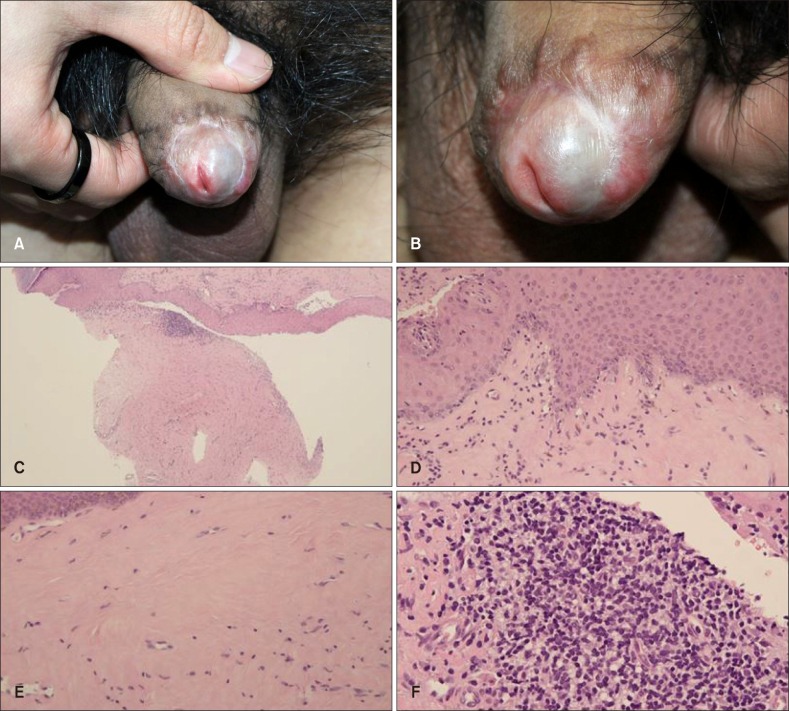Dear Editor:
Lichen sclerosus (LS) is a chronic, inflammatory, mucocutaneous disorder of the genital and extragenital skin that present with significant sclerosis and atrophy. According to a recent study by Nelson and Peterson1, the prevalence of male LS was only 0.0014% in a population of 42,648,923 male patients. Male genital LS (MGLS) develops almost exclusively in uncircumcised patients2. MGLS can cause itching, pain, and burning sensation of the penis. Furthermore, it can cause urinary or sexual dysfunction3. We report a rare case of circumferential balanopreputial adhesion due to MGLS.
A 21-year-old man presented with a whitish atrophic patch on the glans and prepuce for several years. Six months before visiting Pusan National University Hospital (PNUH), he underwent emergency circumcision because of acute urinary retention and paraphimosis. However, the circumcision had not been fully performed due to adhesion of the glans and foreskin around the whitish atrophic patch. After the operation, his voiding function was conserved until the day of visiting PNUH. However, physical examination showed an unretractable prepuce with complete circumferential balanopreputial adhesion (Fig. 1A, B). Histopathological findings showed cleft like space separating basal layer from pale upper dermis. Hydropic degenerations of the basal cells and lymphocyte infiltrations in the upper dermis were also seen. Mild homogenous collagen bundles in the upper dermis were observed compared to relatively normal deep dermis (Fig. 1C~F). Based on these findings, we diagnosed the lesion as LS. The patient was referred to the urology department for reconstructive surgery, but he refused any further invasive treatment.
In Korea, MGLS is an especially rare dermatosis, and we assume that the extremely high circumcision rate among Koreans might be the leading cause of its rarity. Furthermore, circumferential balanopreputial adhesion due to MGLS has not been reported in Korean literatures (Table 1). Despite the significance of urinary or sexual dysfunction in patients with MGLS, most of the Korean dermatologic reports are not focused on the functional loss in patients with MGLS (Table 1). Our patient had not only a skin lesion but also voiding difficulty due to paraphimosis. Although skin biopsy was not performed at that time, we presumed that the paraphimosis might have been caused by the inner adhesion of glans and prepuce that had been triggered by the long lasted MGLS lesion. Moreover, a complete circumferential balanopreputial adhesion and unretractable prepuce could induce sexual dysfunction and urinary dysfunction in the near future. Chronic exposure to urine has been proposed to play a role in the etiogenesis of MGLS. Especially in uncircumcised males, dribbled urine becomes occluded between the inner prepuce and glans. Occlusion and koebnerization precipitate inflammation, which progresses to sclerosis4. The incidence of MGLS in Korea is expected to increase after a few decades, as the circumcision rate in Korea is steeply decreasing5. Therefore, Korean dermatologists should always be aware that functional impairment could be caused by MGLS, as in our case. Thus, we described a rare and instructive Korean case of MGLS with circumferential balanopreputial adhesion.
References
1. Nelson DM, Peterson AC. Lichen sclerosus: epidemiological distribution in an equal access health care system. J Urol. 2011; 185:522–525. PMID: 21168879.

2. Mallon E, Hawkins D, Dinneen M, Francics N, Fearfield L, Newson R, et al. Circumcision and genital dermatoses. Arch Dermatol. 2000; 136:350–354. PMID: 10724196.

3. Edmonds EV, Hunt S, Hawkins D, Dinneen M, Francis N, Bunker CB. Clinical parameters in male genital lichen sclerosus: a case series of 329 patients. J Eur Acad Dermatol Venereol. 2012; 26:730–737. PMID: 21707769.

4. Bunker CB, Shim TN. Male genital lichen sclerosus. Indian J Dermatol. 2015; 60:111–117. PMID: 25814697.

5. Kim D, Koo SA, Pang MG. Decline in male circumcision in South Korea. BMC Public Health. 2012; 12:1067. PMID: 23227923.

Fig. 1
(A) The prepuce was unretractable due to circumferential adhesion of the glans and prepuce on the coronal sulcus. (B) Whitish atrophic patches on the glans and prepuce were observed. (C) Infrabasal inflammation with cleft like space separating the basal layer from the pale upper dermis (H&E, ×40). (D) Hydropic degenerations of the basal cells (H&E, ×200). (E) Mild homogenous collagen bundles in the upper dermis (H&E, ×200). (F) Infrabasal inflammatory cells mostly consist of lymphocytes (H&E, ×400).

Table 1
Korean reports of male genital lichen sclerosus





 PDF
PDF ePub
ePub Citation
Citation Print
Print



 XML Download
XML Download